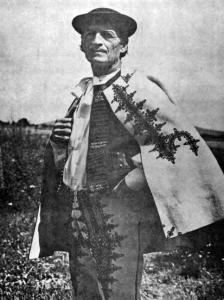Part II: New World Beginnings
Employment Opportunities
It has been ascertained that the average assets of an incoming immigrant were $11.42. Even if he invested all that he had for a piece of land to farm he would have to wait at least a season for some returns, and he could not afford to do that. Besides, many an immigrant did not care to make a permanent commitment like outright ownership of property because there was always the prospect of a possible return to the homeland. Almost every immigrant hoped to make some earnings and then try to improve his situation in the homeland. He was eager for immediate work with his hands and his physical strength, and an opportunity for prompt pay for his work. Mines and industries could offer these and so immigrant workers steadily gravitated toward mines, steel mills, oil refineries, textile works, factories and coke ovens. Some went to railroad and canal construction jobs.
Laborers Worth Their Mettle
Northeastern Pennsylvania had rich resources in hard coal and employed great numbers of Slovak men who proved to be highly desirable workers. Though many were inexperienced in this kind of work and had a severe language handicap, they became diligent and productive miners with a natural capacity to work long hours and with stamina to endure great physical hardships. They were men of moral conviction who felt that it was their duty to give an honest day’s work for an honest day’s pay, small as that was on many occasions. Unfortunately, their faith in man was not always well placed, and, as underlings dependent on a mine supervisor or on a mine boss, they were sometimes taken advantage of and even short paid. Their physical strength and endurance often kept them at menial jobs because, sadly enough, a man was too often esteemed for what he could produce rather than for what he was.
Allegheny-Pittsburgh was the center for working the soft coal mines of Westmoreland and Fayette counties. The Frick Company also hired hundreds of Slovaks to work at its coke ovens. By 1889 there were about 35,000 acres of land with available coal deposits and 15,000 coke ovens under the management of Henry Clay Frick, and when he merged with Andrew Carnegie’s steel works in that year, their combined industry employed 30,000 workers.
A giant industry of this kind welcomed Slovak laborers and a newly arrived immigrant welcomed the opportunity to be hired. Even if he was just a “yard laborer,” one of the lowest paid employees here in 1890, he earned $1.40 for a 10-hour day and he could hope to improve his standing and his earnings. A “road-man” made maximum earnings of $2.10 for a 9-hour day. His take-home pay every two weeks averaged $16 to $25. It must be remembered, however, that this was in a day when one could buy a pound of soup meat for 3 cents, a fairly good suit of clothes for $6, and a pair of shoes for $2.
The steel plants of Youngstown and the industrial shops and iron works in Akron and Cleveland attracted many Slovaks to Ohio. New York, New Jersey, Connecticut, Massachusetts and Illinois similarly offered employment in industry, business, railroad building and private enterprise. New Jersey needed a great labor force for its oil refineries. Passaic, New Jersey had a number of textile plants and those who were experienced in weaving and fabric manufacture were happy to use their skills there.
Women Laborers
Many of the single women from Slovakia who did not find domestic work and housekeeping chores attractive, settled in Passaic and worked in textile factories, garment and shirt-making plants, lace making, and handkerchief shops. Eventually there was much matchmaking in this community and if a young man without attachments decided to visit Passaic, he generally returned with a wife or a fiancée whom he would shortly marry!

